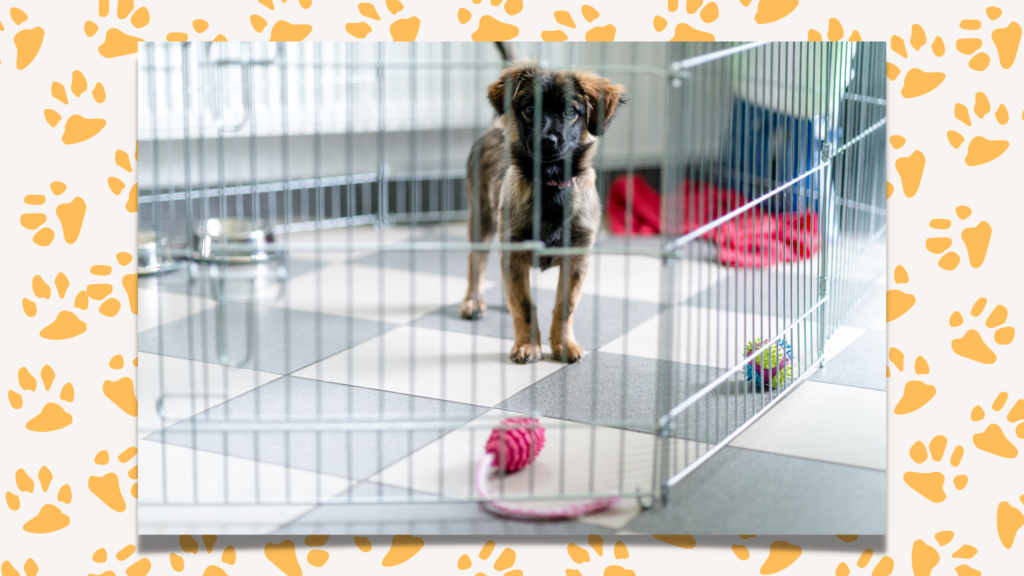
Who doesn’t dream about having a well-behaved dog ? That doesn’t tear your stuff up and goes to the bathroom outside?
Just so you know crate training is an important part of that. It creates a safe place that belongs to your dog only.
We know some may view crates through the human lens and say they’re “caged up”. But we have to remember that dogs are naturally den animals and most will enjoy being in small, enclosed places. A crate brings them the feeling of security, and when trained to use them from an early age, crates can help calm anxiety.
AKC talked to Anna Flayton, senior dog trainer for PUPS Pet Club in Chicago, for her advice on how to crate train your dog.
Here are the top 9 tips for crate training:
Tip #1: Choosing the right crate
We believe that finding the best crate for your dog is key to a successful training.
According to Anna Flayton, senior dog trainer for PUPS Pet Club in Chicago, “You want to get one that’s durable, comfortable, and flexible with whatever training you’re doing”. Some dogs actually prefer to sleep in the dark, so the recomendation is a kennel or airline crates (which are more enclosed), while wire crates will work best for other dogs. Flayton also notes it’s important that you don’t buy a crate that is too big for your dog and says: “Depending on how big your dog is going to get, buy the right crate for their adult size,” she advises. “Then get a divider so you can build the space and grant them more and more space.”
Tip #2: You have to establish the Proper Mindset
Flayton emphasizes: “The more the dogs associate the crate with a relaxed mindset, the more they’ll ultimately enjoy hanging out in there,”. If your dog is playing and running around, then they’ll want to come back out and continue to play. On the other hand if you bring them in it when they’re calm, they will likely sense it as a place of rest. Bringing them in for 10 minutes at a time and then start working your way up from there is the best way to start.
Tip #3: Let Your Dog determine what’s the Most Comfortable
it’s trial and error process. Some may use dog beds or towels to create a comfy environment, but that’s not a rule. Flayton says “Depending on the dog you have, they may tear a dog bed apart or they may use it to pee on,”. And she also reinforces that “It’s not a bad thing for them to just sleep on the crate mat itself. Dogs actually do prefer hard surfaces.”
Tip #4: Reward the Dog with a Treat After They Go Into the Crate
The positive association rules are the best and applied with creativity can be a game changer in the crate training. For example, one of Flayton’s favorite tricks is giving the dog a KONG toy filled with peanut butter that she’s put in the freezer first. “When they’re hanging out in the crate, they have something that stimulates them, but they have to work down the frozen peanut butter,” she says. It gets the dog used to being in the crate for a longer period of time, while also associating it with an enjoyable activity.
Tip #5: Keep Your Dog “Naked”
Flayton warns us “Dogs should never, ever have collars or tags or anything on when they’re in the crate”. If the tag gets caught in the crate the dog could strangle.
Tip #6: Play Fun Crate Games
To ensure that your dog doesn’t see the crate as a negative place, incorporate some fun games. Flayton said she likes to throw the ball in the crate when playing fetch or hide treats inside for the dog to find. That way the pup goes in and out of the open crate at their own will.
Tip #7: Eye on the Time
Dogs don’t want to soil where they sleep, but if there’s too much time without a walk, they might end up doing so. Remember that your dog needs time outside the crate to play, eat, and use the bathroom and be free!
Tip #8: You Have to Set Your Dog Up for Success
Take small steps when you are ready to give your dog more time inside the crate. “You don’t want to go out to dinner for six hours,” cautions Flayton. “Maybe just go get a cup of coffee and come back.” She also says that, if you can, use a recording device to determine what your dog does while you’re gone. “Are they anxious? Are they pacing? Or are they calm?” she says. “Then you know — and when you come back, you can reward them.”
Tip #9: Patience is Key
You have to be prepared for at least six months of crate training. There are no linear learners, so be aware that there will be ups and downs, but success will come, and Flayton emphasizes “Even when it feels like you’re banging your head against a wall, as long as you stay calm and consistent in your methodology, your dog will eventually look for the reward and you’ll have the opportunity to reward them.”
Bonus
We know it mind sound like a lot. But the effort is worth so you can have a safe environment for your dog and more your dog will be a joy to be around and play with.
And last but not least. We recommend acquiring some training knowledge, for that reason we find Brain Training For Dogs the best option. First because it doesn’t matter if your dog is still a puppy or already adult; and second because you get force-free, easy to understand directions, troubleshooting guides, step-by-step guides, and pictures and video demonstrations you can use with any dog to quickly unlock his natural intelligence and eliminate bad behaviors.
Adrienne Farricelli is a professional CPDT-KA certified dog trainer will personally provide support to you through her easy-to-use support system. Her many years of expertise will guide you to success.
Click Here to have access to Brain Training For Dogs right now!
Conclusion
Well, at the end of the day if you embrace the whole process with consistency, love and patience, sooner than later you’ll be enjoying the days with your dog without having to worry about his behavior, even when you’re not home! 🐶
Resources and references: AKC


Your articles are extremely helpful to me. Please provide more information!
I really appreciate your help
Thank you for writing this post!
Awsome website! I am loving it!! Will come back again. I am bookmarking your feeds also.